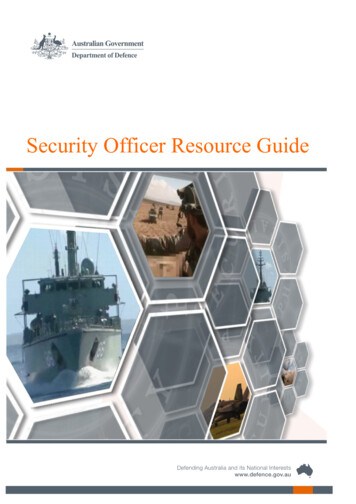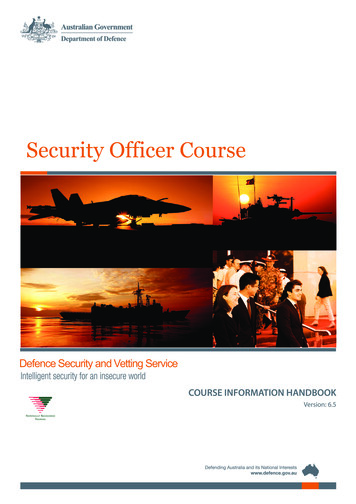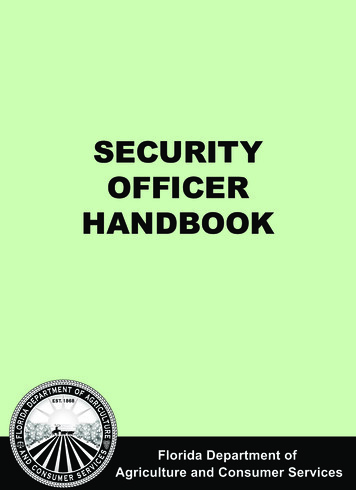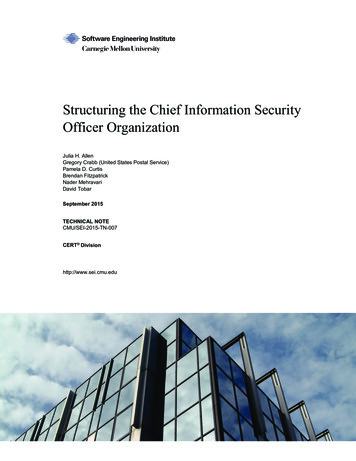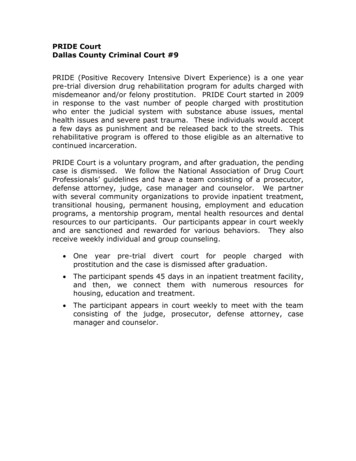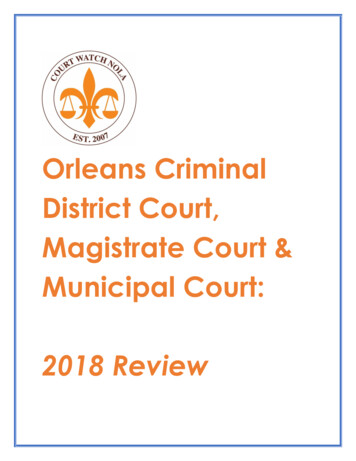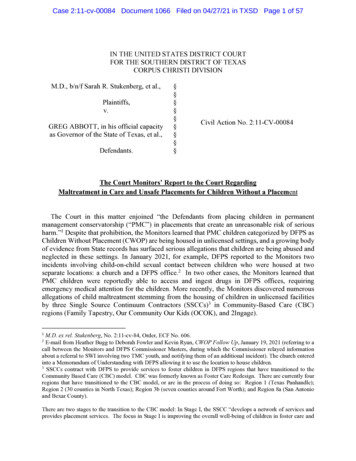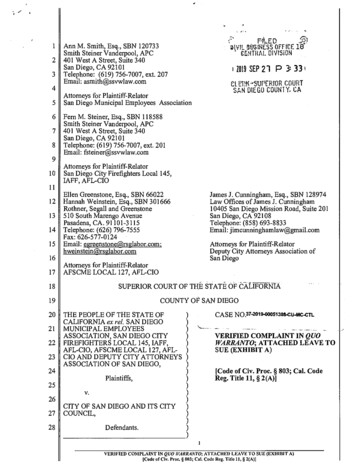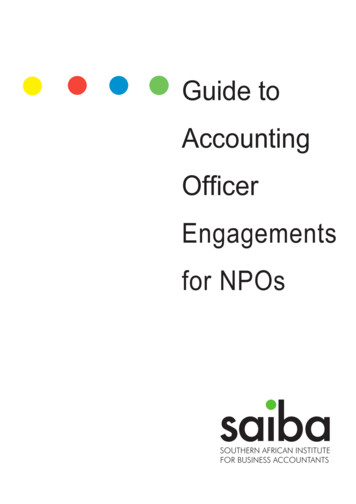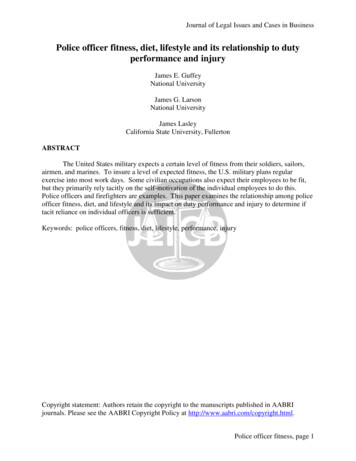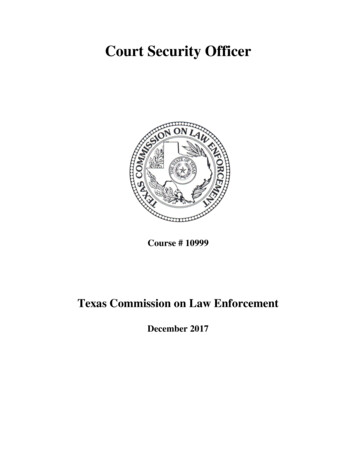
Transcription
Court Security OfficerCourse # 10999Texas Commission on Law EnforcementDecember 2017
Court Security Officer(TCOLE Course: 10999)Abstract:The purpose of the Texas Commission on Law Enforcement (TCOLE)approved course for the Court Security Officer class is to give the courtsecurity officer a basic understanding of the threats associated with courtsettings as well as technology and techniques for court security operationsin compliance with Government Sec. 158.002.To qualify for a Court Security Certificate, an applicant must meet allproficiency requirements per Texas Administrative Code Title 37, Part 7,Chapter 221, as well as completion of course #10999.It is the responsibility of the training coordinator to ensure that lessonplans are constructed for each of these courses per the attached courseobjectives and instructor resource guide and this curriculum and lessonplans are kept up to date and on file at your individual department oracademy. This procedure should be completed per guidelines obtainedfrom the rules section of the commission website at: www.tcole.texas.gov.The committee recommends continuing education in court security up toand including the TCOLE court security specialist certificationcurriculum.Hour Submission Criteria:Due to the legislative mandate status of this course: It can only be reported and submitted in the TCLEDDS electronicreporting system by an academy or a contract training provider. Students who do not have a PID number due to non-licensure statuswill need to obtain such through submission of a C1 by a trainingprovider. Certificates of completion should be given to students by the trainingprovider at successful completion of course. Additional proof of course completion can be obtained by:o TCOLE PSR print out ORo If desired, a formal certificate from TCOLE obtained bycompletion of TCOLE request form and a fee of 35.00.Equivalency:TCOLE Court Security Specialist CertificationInstructor(s):TCOLE Court Security Specialist or documented subject matter expert toinclude experience in content area of court security or similar securityareas.
Prepared by:This version of the instructor resource guide was prepared by the TCOLEcurriculum committee consisting of: Susan K. Gregory-Brundage,TCOLE; Constable Randy Harris, Tom Green County Pct. 4; MarshalJohn Morris, City of Waxahachie; Chief Deputy Constable BobbyGutierrez, Travis County Pct. 5; Sgt. Terry Fahrlender, Lubbock CountySheriff’s Office; Sgt. Derrick Wagoner, Arlington Police Department;Chief Scott Rubin, Fair Oaks Ranch Police Department; Officer FredPitcher, Georgetown Police Department; Scott Griffith, Texas Office ofCourt Administration.Time Allotted:Minimum of 8 hours for this cohort and no more than 16 hours.Target Population: This course is intended for all personnel designated to obtain basiccertification in court security pursuant to Government Code Section158.002.Prerequisites:None are requiredNumber of Students:The number of students is limited to the size of the classroom capacityand number of available seats if conducted in classroom environment.Space Requirements:A standard classroom with sufficient seating for all participants to takenotes if conducted in classroom environment.Evaluation Procedure: Each participant must actively interact in the learning environment aswell as complete evaluative tools as instructor and department deemsappropriate.If a written exam is given, a minimum passing score of 70% or highermust be rio/Role-PlayClass Discussion orOnline interactive environmentTraining Material:LCD projectorMovie screen or clear wall spaceComputer with presentation software (PowerPoint, Keynote or otheronline presentation interactive software if conducted in an onlineenvironment)Note taking materialHandoutsTest and answer key
Learning Objectives:Introduction to Court SecurityGoal: Provide the student with the history of court security and the recent legislationaffecting court security.1.0 Summarize the history of court security2.0 Cover Senate Bill 42 and its provisions3.0 List allowable collection and use of the court security fundsBailiff Function in Court SecurityGoal: Basic information of the bailiff’s role in court security and their respectiveduties to the court.1.0 Bailiff duties and security2.0 Jury protection3.0 Emergency plansCourt Security Screening BasicsGoal: Basic methods and implementation of security screening1.0 Legal aspects of court security screening2.0 Available court security screening equipment and processes3.0 Incident reports and screening evidenceExplosives Recognition and AwarenessGoal: Basic familiarization with explosives and their connection with the courtsecurity function1.0. Familiarize court security personnel with explosives and their illicit uses2.0. Familiarize court security personnel with basic methods of prevention anddetection of explosive devices in a court security setting3.0. Familiarize court security personnel with basic methods of responding topotential or actual explosive devicesCourt Security TechnologyGoal: Basic understanding of current technology as it relates to court protectionpractices1.0 Familiarize court security personnel with available technology related to courtsecurity2.0 Familiarize court security personnel with relevant purchasing, repair, andinstallation informationJudicial ProtectionGoal: Basic understanding of Judicial Protection1.0 Suggested practices to enhance judicial security2.0 Suggested personal protection information for judgesCase StudiesGoal: Analyze known incidents in court security and review them for educational valueand solutions.
1.0 Students will critique provided scenarios2.0 Students will analyze case studies
Instructor Resource Guide:Overview This course consists of basic information on court security. This instructor resourceguide has been developed to help in the ease of presenting the information toparticipants and to assist instructors in organizing the overall program. The following is covered in this guide:o The program abstract (see abstract above)o The program goals and objectives (see above)o The program contents Introduction to Court Security Bailiff Function in Court Security Court Security Screening Basics Explosive Recognition and Awareness Introduction to Court Security Technology Judicial Protection Court Security Case StudiesIntroduction to Court SecurityGoal: Provide the student with the history of court security and the recent legislationaffecting court security.1.0 Summarize the history of court securityo Overview of significant events affecting court security and relevance tocourt security Assassination of U. S. District Judge John Wood in San Antonio(significance – origination of the Federal Court Security Program) Attack at the Smith County Courthouse Tyler, TX February 2005(significance – lack of long guns available to court securityscreeners to defend against an attack of this magnitude) Prisoner attack and escape resulting in 4 deaths at the FultonCounty Courthouse, GA March 2005 (significance – liabilityrelated to mandatory attendance in court by law enforcement asrequired by law as it relates to Texas statutes) Attack on Travis County Judge Julie Kocurek at her home(significance – the origination of Senate Bill 42)2.0 Describe Senate Bill 42 and its provisionso Training Mandates Government Code Chapter 158 Occupations Code 1701.267o Court Security Committees Government Code 29.014, 30.00007, 74.092(13)o Protection of Judges Outside of Jurisdiction Government Code Sec 411.0485o Mandatory Court Security Reporting
CCP 102.017 (f)o Protection of Judges’ personal information Government Code 72.016, 552.117, 572.002, 572.035; ElectionCode 13.0021, 15.0215; Local Government Code 133.058;Property Code 11.008; Tax Code 25.025 (Cover more in depth inJudicial Protection section)o Establishment of fees and grants for Court Security Training Government Code 51.791, 101.06111, 106.08111, 101.10111,101.12121, 101.1411, 56.003 (h), 56.004 (b)(3)o Establishment of Court Security Division Government Code 72.0153.0 List allowable collection and uses of the Court Security Fundo CCP 102.017Bailiff Function in Court Security Goal: Basic information of the bailiff’s role in court security and their respectiveduties to the court.1.0. Explain Basic Bailiff Duties and Security practiceso Basic Bailiff Duties Search the courtroom prior to use and after use or after breaks Look for anything that should not be there or does notlook right (looks suspicious)o Positioning Three components of tactical positioning in the courtroom Be visible to everyone in the courtroom Be able to see all entrances to the courtroom Be able to intervene if anyone rushes the bench or juryboxo Securing of unruly prisoners during trial Deck vs. Missouri 544 U.S. 622 (2005) Illinois vs. Allen 397 U.S. 337 (1970) Prevent jurors from seeing defendant in restraintso The rule Monitoring of witnesses in the courtroomo Threat Assessment Pre-planning and research of upcoming dockets Communication with court staff on known issues withsubjects Victim impact statements2.0. Explain Jury Protectiono Jury Protection During jury selection During trial
During deliberationAfter trialPrevention of mistrial from improper conduct3.0. Outline Emergency plans and considerationso Emergency Plan Considerations Disruptiono In the courtroomo Outside the courtroom Active shootero In the courtroomo Outside the courtroom Communicationo Adequate emergency communication Duress buttons Radio Phone Evacuationo Fireo Weathero Bomb ThreatCourt Security Screening Basics Goal: Basic methods and implementation of security screening1.0.Explain Legal aspects of court security screeningo Review of case law on court security screeningo Downing v. Kunzig, 454 F.2d 1230 (1972)o Barrett v. Kunzig, 331 F.Supp 266 (1971)o McMorris v. Alioto, 567 F.2d 897 (1978)o Jensen v. City of Pontiac, 113 Mich App 341; 317 NW2d 619(1982)o People v. Alba, 440 NYS2d 230 (1981), app dismd 450 NYS2d787, 436 NE2d 193o Commonwealth v. Harris, (Mass 1981) 421 NE2d 447o Administrative search testo Mandatory signage as required by case law on screeningo Implied consent to search based on signageo Requiring identification as a condition of entry into the courthouseo United States v. Wendell Smith, Docket No. 03-1588-cr (2dCir. Oct. 17, 2005) (Winter, Sotomayor, Parker)o Waller v. Georgia, 467 U.S. 39, 45 (1984)2.0.Compare and contrast available court security screeningequipment and processeso Equipment
o Magnetometerso X-ray machineso Held-held screening wandso Trace detectorso Identification card systemso Procedureso Policyo Who do you search Employees Law Enforcemento Prohibited items Weapons Penal Code 46.03; 46.035 Contraband Illegal drugs, cuff keys, items harmful to courtenvironment etc. Items prohibited by court order or rules Weapons that are legal to possess but restrictedby court ruleso Legal knives, scissors, crochet needles,chemical sprays, electronic weapons,etc. Phones, electronic devices, backpacks, largehandbags, etc.o Methodso Hand searcheso Metal detector searcheso X-ray machine searches3.0.ooooSummarize incident reports and screening evidenceFollow departmental policyReports must contain the following questions at a minimum: Who What Where When Why/HowAdditionally reports should contain:o Information on security signage present and the verbiageincludedPhotograph all evidenceo Security signageo Screening areao Items seizedo Images on X-Ray equipmento Equipment used to make the detection
o Follow department policy on chain of custody and evidencesubmissionExplosives Recognition and Awareness Goal: Basic familiarization with explosives and their connection with the courtsecurity function1.0. Familiarize court security personnel with explosives and their illicit uses2.0. Familiarize court security personnel with basic methods of prevention anddetection of explosive devices in a court security setting.3.0. Familiarize court security personnel with basic methods of responding topotential or actual explosive devices.Note to Instructor:ooooDue to the nature of explosive detection and handling, all students shouldbe reminded that this is not an EOD tactics or explosive handling class.This is only a class for basic explosives information.Recent incidents at court facilities (bomb threats, explosive incidents)Improvised explosive devicesHome grown terrorismDetection and response to possible know explosive devicesCourt Security Technology Goal: Basic understanding of current technology as it relates to court protectionpractices1.0. Familiarize court security personnel with available technology related tocourt security2.0 Familiarize court security personnel with relevant purchasing, repair, andinstallation informationo Equipmento CCTVo Body Cameras Judge’s Policy on use of cameras courtroomo Access Controlo Identification Systemso Alarms Intrusion Fire Panic/DuressJudicial Protection Goal: Basic understanding of judicial protection practices.1.0 Discuss suggested practices to enhance judicial security
o Parking loto CCTV coverage of judicial parking and routes to and from thecourt buildingo Fenced parking if possibleo Bailiffs should escort judges to and from vehicleso Keep parking lots well lito Do not mark judicial parking spaces “judge” or anything thatwould identify that the space is assigned to a judgeo Always inspect the interior of the vehicle before getting insideo Provide the judge with personal duress alarmo Buildingo Bailiffs should escort the judge to and from the courtroomo Chambers should always remain lockedo Courtrooms should remain locked when not in useo Judges should have emergency plans in place for the following toaddress all locations in the building: Active shooter Disturbances Severe weather Bomb threat Evacuationo Security equipment Panic/Duress alarms CCTV systems Access control systems Designated safe roomso Judicial Threatso Threat assessmento Home securityo Transportation securityo Is the judge armed? Qualification with officers2.0 Interpret suggested personal protection information for judgeso U. S. Marshals self-assessment for judgeso Judicial personal safety checklisto Protection of Judges’ personal information Government Code 72.016, 552.117, 572.002, 572.035;Election Code 13.0021, 15.0215; Local Government Code133.058; Property Code 11.008; Tax Code 25.025Case Studies Goal: Analyze known incidents in court security and review them for education andsolutions.
1.0 Students will critique provided scenarioso During each module of training students will be asked to critiqueexamples related to that module.2.0 Students will analyze caseo Examples will be presented throughout the training with the goal offinding solutions to issues presented in the case studies.References:This is a list of suggested reference for materials for training. Instructors should not limitthemselves to this list but should search out other information as well so that the learningobjectives are met.o Department of the Treasury – Bureau of Alcohol, Tobacco and Firearms,“Letter and Package BOMB Detection cuments/ATF%5Cbomb broch.pdfo CCJ/COSCA, “Court Security Handbook: Ten Essential Elements for CourtSecurity and Emergency Preparedness”o Rob DeGroot, “The Customer is not Always Right: A Common SenseApproach to Safety and Security in the Courthouse”o Timothy F. Fautsko, (2008) “Entry Screening: The Court’s First Line ofDefense” ourtsecurity/resource-guide.aspxo Timm Frutsko, Steve Berson and Steve Swensen, “Courthouse SecurityIncidents Trending Upward: The Challenges Facing State Courts Today,”(2012) security-incidents.aspxo “Gavel to Gavel,” http://gaveltogavel.us/tag/texas/o Court Security for Judges, Officers and other Court Personnel, Judge RichardCarter and Constable Randy Harris, ges-officers-and-court-personnel.htmlHistory of Court Security, of-court-securityo Manuals and Standards, www.courtsecurityconcepts.como National Center for State Courts, “Court Security Resource al/collection/facilities/id/170
o National Center for State Courts (2010), “Guidelines for Implementing BestPractices in Court Building Security” Guidelines.aspxo National Incident Management System (NIMS) (2011), “Overview”o National Institute of Justice, “Court Security and the Transportation lt/files/tb/images/benefits/fs000165.pdfo Special Agent James Oswalt, Texas Commission on Law Enforcement,“Bailiffs 101/Courtroom Security”o PoliceOne.com, “Courthouse curity/o Texas Code of Criminal Procedure, Chapter 102 – Cost Paid by Defendantso Katie Tefft, Program Attorney, TMCED, “Municipal Court Building Securityand Technology Funds”o U.S. Department of Justice, United States Marshal Service, “Strategic Plan:2012-2016, Online Edition” www.usmarshals.govo Vermont Judicial Branch (1993), “Court Security Specialist”
(TCOLE Course: 10999) Abstract: The purpose of the Texas Commission on Law Enforcement (TCOLE) approved course for the Court Security Officer class is to give the court security officer a basic understanding of the threats associated with court settings as well as te
